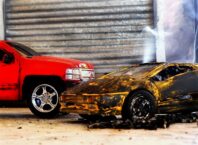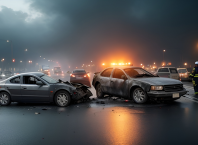One of the most common pieces of advice you’ll get when getting into a car accident is to take pictures of the scene for evidence. While this advice would undoubtedly go a long way in proving your claim and winning the case, people don’t really tell you which kind of photos you should take. After all, not all photographic evidence is good evidence—some may even work against you.
Before you go on a spree taking pictures around the scene, in this article is a quick list of the type of photos you might want to focus on taking when you’re involved in a car accident.
Contents
1Take A Photo Of Each Vehicle Involved
Among the countless photos you can take at the scene, one that shows the vehicles involved is perhaps the most valuable photographic evidence you can get, and for many reasons.
One, these photos can show the insurer the extent of property damage, which will serve as a good metric for how much the other party should pay you for settlement. Two, the other party’s vehicle might have some conclusive evidence that their negligence caused the accident. For instance, there might be a bottle of alcohol, suggesting the driver was intoxicated while driving.
Simply put, make sure you take a couple of photos of your vehicle as well as the other party’s vehicle. Remember that the picture should show the original location of the vehicles, not its location after someone moved it, so it’s best to take the photo immediately after an accident unless, of course, you sustained a relatively severe injury.
Take note, however, that you can’t win a case with purely photographic evidence. You also need someone to use this evidence in your favor, and that someone would be a lawyer.
Having said that, you might want to consider typing for a “lawyer near me” on the internet if you want to increase your chances of winning the case and maximize your settlement amount.
2Take A Photo Of Your Injuries
Just like how property damage can increase your chances of winning, your injuries will be your advantage to stack the favor in your odds. Moreover, if you’re not the only victim of the accident, consider taking a photo of their injuries as well. It’d be best if you can take the photo of your injury and the injuries of other victims right after the accident.
Although this may seem a bit ghastly, the fresher the wound is, the better, since it shows more details that way. Getting a close-up shot would be ideal.
Typically, a severe injury, especially one you’re still recovering from, would maximize your chances of winning the case. But if that weren’t the case and the injury looks no more than a scratch, it might be best to omit such photos and simply focus on the other areas of the scene of the accident.
3Take A Photo Of The Entire Scene
While the driver might’ve been the main cause of the accident, some objects in the background could’ve played a part in the accident. These may include:
- traffic signs,
- bumps in the road,
- weather at that time of the day,
- damaged curbs,
- lamp posts, and
- security cameras.
Capturing these details can also prove useful in case the driver omits these details in their statements. Besides, in a car accident, the slightest details count. Since you probably won’t have enough time to take a picture of everything in the scene, your best bet is to simply take a photo of the entire scene.
You can do so by moving away until you can fit the entire scene in your frame, then take a picture. Also, consider taking the photo from different angles, so no details are left out. For instance, you can try taking a picture from 5 feet, 10 feet, and 20 feet from the scene. However, you have to remember that certain areas are more critical than others. One particular detail that you should always include are the skid marks.
4Take A Photo Of The Skid Marks
While “skid marks” isn’t exactly the term you’ll hear the most when dealing with a car accident, take note that these details are extremely valuable. For your reference, skid marks are the visible marks you see on the road right after an accident. These marks result from tires sliding, spinning, or skidding on the surface of the road.
While you may think they’re nothing more than just marks, forensics and investigators use these skid marks to get a general idea of what transpired in an accident. This usually allows them to accurately determine who’s at fault and who’s the victim, so investigators are most likely going to take a photo of skid marks. But just in case, you should have your own photo as well, preferably one taken immediately after the accident.
Word Of Advice: Use Objects For Scale
One of the main problems you’ll face when taking a photo of any damage to your property is that people aren’t aware of the extent of the damage. For instance, you can take a picture of a scratch in your car, but the photo alone won’t tell them how big of a scratch it is unless you add an object for scale, and that’s precisely what you want to do every time you take a picture.
Ensure the photo includes an object that would give a sense of scale, such as a smartphone, a hat, or even your hand. This would allow the insurer to know how much damage you’ve suffered from the accident, allowing them to accurately decide on the amount of victim compensation.
Conclusion
Photographic evidence goes a long way in helping you win a case. Although taking numerous pictures at the scene can be troublesome, it’s one of the things you shouldn’t neglect. Also, if the phone you had after the accident doesn’t produce crystal-clear images, you can go back to the scene and take a photo with a high-quality camera. Some of the essential details should still be in the scene, such as the skid marks, damage to signages, and the likes.












